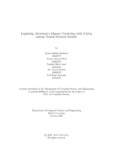| dc.contributor.advisor | Parvez, Mohammad Zavid | |
| dc.contributor.advisor | Reza, Md. Tanzim | |
| dc.contributor.author | Rahman, Quazi Ashikur | |
| dc.contributor.author | Shad, Hamza Ahmed | |
| dc.contributor.author | Asad, Nashita Binte | |
| dc.contributor.author | Bakshi, Atif Zawad | |
| dc.contributor.author | Mursalin, S.M Faiaz | |
| dc.date.accessioned | 2022-02-28T04:38:11Z | |
| dc.date.available | 2022-02-28T04:38:11Z | |
| dc.date.copyright | 2021 | |
| dc.date.issued | 2021-10 | |
| dc.identifier.other | ID 18101577 | |
| dc.identifier.other | ID 18101279 | |
| dc.identifier.other | ID 18101622 | |
| dc.identifier.other | ID 18101679 | |
| dc.identifier.other | ID 18101508 | |
| dc.identifier.uri | http://hdl.handle.net/10361/16362 | |
| dc.description | This thesis is submitted in partial fulfillment of the requirements for the degree of Bachelor of Science in Computer Science and Engineering, 2021. | en_US |
| dc.description | Cataloged from PDF version of thesis. | |
| dc.description | Includes bibliographical references (pages 50-52). | |
| dc.description.abstract | Using a number of Neural Network Models, we attempt to explore and explain the
prediction of Alzheimer's in patients in various stages of the disease, using MRI
imaging data. Alzheimer's disease(AD) often described as dementia is one of the
major neurological dysfunctionalities among humans and does not yet have a proven
detection system; unless the nal stage symptoms of AD starts to be seen. It is observed
that multimodal biological, imaging and other available neuropsychological
data can ensure a high percentage of separation among (AD) patients from cognitively
normal elders. However, they cannot surely predict or detect early enough
that patients with early signs of mild cognitive impairment (MCI) can develop into
Alzheimer's disease dementia in the future. But the research done till date shows
a high probable detection rate in which they used the pattern classi er built on
various longitudinal data. So in this paper we experimented with the existing Neural
Network models to detect Alzheimer's disease in its early stage by classi cation
techniques; and will be using a recent hybrid dataset in the process to have four
separate classi cation in total. And also explored the exact region for which that
speci c classi cation occurs for the patients, looking at the T1 weighted MRI scans
from a hybrid dataset from Kaggle [21] using the LIME based XAI(Explainable Arti
cial Intelligence) framework. For the Convolution Neural Network Models we are
using Resnet50, VGG16 and Inception v3 and received 82.56%, 86.82%, 82.04% of
categorical accuracy respectively. | en_US |
| dc.description.statementofresponsibility | Quazi Ashikur Rahman | |
| dc.description.statementofresponsibility | Hamza Ahmed Shad | |
| dc.description.statementofresponsibility | Nashita Binte Asad | |
| dc.description.statementofresponsibility | Atif Zawad Bakshi | |
| dc.description.statementofresponsibility | S.M Faiaz Mursalin | |
| dc.format.extent | 52 pages | |
| dc.language.iso | en | en_US |
| dc.publisher | Brac University | en_US |
| dc.rights | Brac University theses are protected by copyright. They may be viewed from this source for any purpose, but reproduction or distribution in any format is prohibited without written permission. | |
| dc.subject | Early detection of AD | en_US |
| dc.subject | Alzheimer's disease | en_US |
| dc.subject | CNN model for AD detection | en_US |
| dc.subject | Explainable artificial intelligence | en_US |
| dc.subject | XAI | en_US |
| dc.subject | LIME | en_US |
| dc.subject.lcsh | Neural networks (Computer science) | |
| dc.subject.lcsh | Artificial intelligence | |
| dc.subject.lcsh | Alzheimer's disease. | |
| dc.title | Exploring Alzheimer's disease prediction with XAI in various neural network models | en_US |
| dc.type | Thesis | en_US |
| dc.contributor.department | Department of Computer Science and Engineering, Brac University | |
| dc.description.degree | B. Computer Science | |

